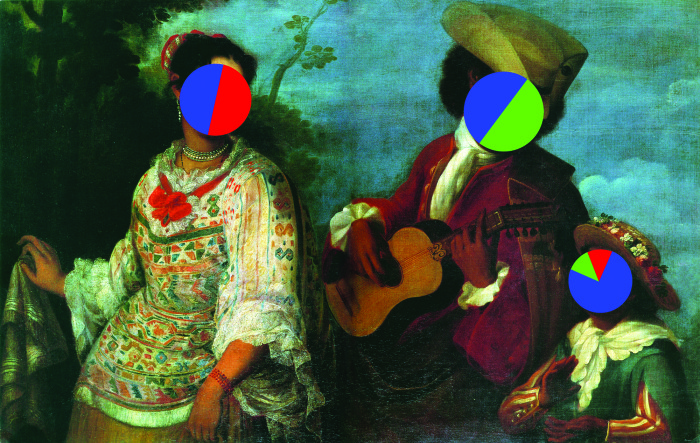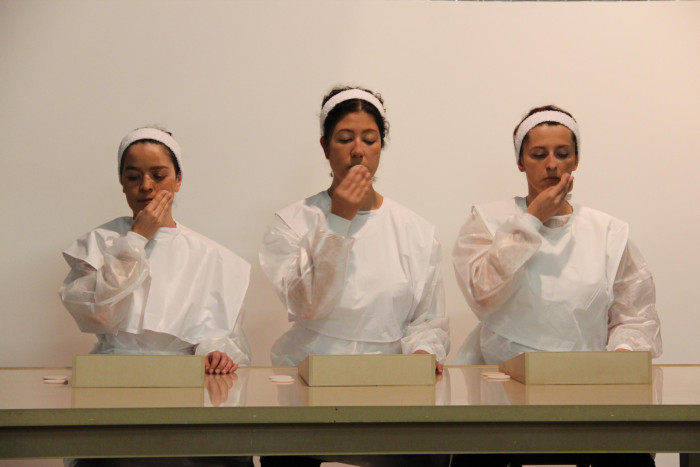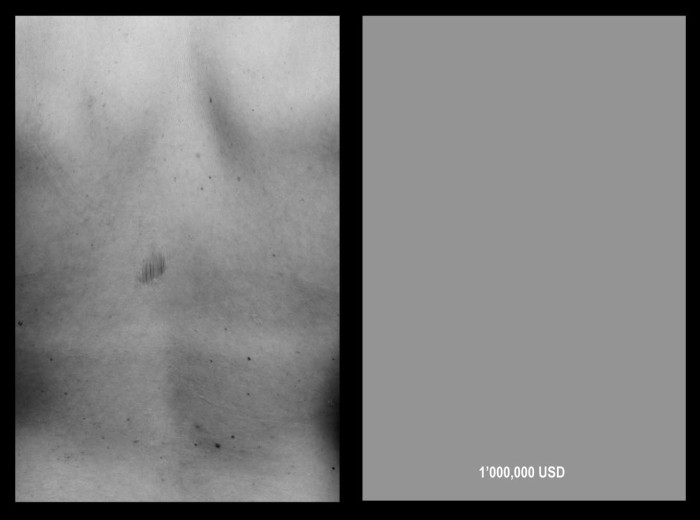
01.01.1970
Susana Vargas Cervantes looks at the work of artists Zach Blas, Colectivo Zunga, Santiago Sierra and Erick Meyenberg through the concept of pigmentocracy.

Despite the fact the relationship between skin-tone and social structures has been present in art since the eighteenth century, in recent years, contemporary art has demonstrated a preoccupation with problematizing this relationship by making it visible or by finding resistance within invisibility.
The Colombian feminist collective Zunga (Karla Moreno, Lorena Morris, Ana María Villate and María Natalia Ávila) takes up these issues by means of New Spain’s (i.e., colonial Mexico’s) so-called casta (“caste”) paintings tradition. At the time, the painting sub-genre emerged in oils, on canvas or copper plates, and portrayed new racial mixes as well as clear social differences that colonial society had given rise to. Caste paintings represented heterosexual couples from different racial groups as well as the outcome of their unions, a young son. The painting was always accompanied by the term that described these people within the caste-classification system. In its 2012 performance Pintura de castas, Zunga takes up terms from eighteenth-century caste paintings by New-Spanish painter Miguel Cabrera (1695-1768) and migrates them to the twenty-first century, making manifest both the impossibility of situating different racial types as well as how “inclusion strategies only respond to situations in which the marginalized population is considered a potential consumer.” The members of the Colombian collective undertook an action in which their four members began applying different shades of women’s make-up onto their faces, particularly different shades of base, while simultaneously reciting the terms that designate the new castes: of Spaniard man and Indian woman is born a mestizo; of a Spaniard man and a mestiza woman is born castizo; of a castizo man and a Spanish woman is born a Spaniard; of a Spaniard and a Negro woman is born a mulatto; of a Spaniard man and a mulatto woman is born a morisco; of a Spaniard and a morisco woman is born an albino” of a Spaniard and an albino woman is born a torna-atrás (roughly, a “turn-back”), etc., etc.

By migrating eighteenth-century classification to the current-day context, the Colectivo Zunga shows how the same discourses of discrimination—through which the pigmentocratic system peculiar to Latin America gives rise to social inequalities—remain in place to date. When I speak of a “system,” I am referring to Gayle Rubin’s feminist contribution with regard to the sex/gender system, in which although sex and gender are not the same thing, she proposes its analysis as a “-a set of arrangements by which the biological raw material of human sex and procreation is shaped by human, social intervention and satisfied in a conventional manner, no matter how bizarre some of the conventions may be” (1975: 165). Within this system, skin tones are perceived based on social and cultural interventions and at once linked to a certain socioeconomic level. In that system as well, class and skin tones, though they are not identical, work as self-reproducing and inter-dependent power apparatuses. I therefore argue that, in Mexico at least, it is impossible to speak of social class without simultaneously speaking of skin tonalities and how its structure constitutes a pigmentocratic “system.”

In 2006, Spanish artist Santiago Sierra completed Estudio Económico de la Piel de los Caraqueños in Caracas. Sierra gathered a series of black and white photographs, accompanied by two statistical tables, regarding the correlation between whiteness and income. First he photographed the back skin of ten people who reported having zero dollars, ten people who reported having a thousand dollars and ten people who reported having one million dollars. Once the three different tones were converted to gray-scale, he deduced the value of the black and white tones in dollars. The artist arrived at a black value of -$2106 USD and a white value of $11,548,415 USD.

In pigmentocracy, skin tones exist in a relational and contextual manner. In other words, in line with thinking by Mónica Moreno Figueroa, whiteness functions as a space of sought after privilege, an aspiration to social belonging. The social meaning of each “color” is molded based on a human intervention on biological raw material. Therefore, whiteness is not always associated with a “white body.” Not all people with white skin occupy a space of legitimacy just because of this; rather, whiteness is a question that—while it includes pigmentation as one of its elements—goes beyond this. Whiteness only exists in relation to other social categories, such as class and the cultural conjunctions that make it possible. Being “white” is not merely a question of a determined color, but also of social relationships and cultural context.
This form of discrimination between racism and classism works based on a social interpretation of certain biological aspects, like features and skin color, characterizing these as alternately “positive” or “negative.” Therefore, in the pigmentocratic system, the white subject exists only in a relational way. In Mexico, the güerito and güerita (roughly, the “fair” or “blond” man and woman, respectively) are defined based on a social perception linked to cultural and symbolic capital, i.e., how they are dressed, what they eat, where they work, with whom they go out, where they vacation, etc.
The Latin American pigmentocratic system has severe implications for power structures when it materializes itself in the labor market (among other markets). As Sierra’s artwork demonstrates, the “whiter” you are, the more likely it is to occupy a higher socioeconomic position. The greatest amount of cultural capital—i.e., educational attainment, intellectual training, ways of speaking and dressing, physical appearance—is held by those with the “whitest” skin tones. Those with less cultural and social capital are those with “darker” skin tones. Starting from the time of the Spanish conquest of what is now Mexico, pigmentocratic society has reproduced and maintained itself.
The caste paintings promoted an ideology of mestizaje—mixed racial heritage—that served and continues to serve as a means to obfuscate persistent racism and classism; if we’re all equal then there is no racism.
In 2010, as part of a group show entitled RevolucionES at Mexico City’s Museo Laboratorio Arte Alameda, Mexican artist Erick Meyenberg presented the installation called Étude taxonomique et comparative entre les castes de la Nouvelle Espagne et celles du Mexique contemporain. Like the Colectivo Zunga, Meyenberg makes visible racial-mixing classifications that began in colonial times, still seen today. To that end, he compares New-World racial constructions with the genetic codes of circa-2009 Mexicans in a sound installation featuring 205 LED rings mounted in a darkroom. The LEDs are programmed to transform from basic RGB (red, green, blue) colors, in reference to the three main “races” that supposedly make up the Mexican population—blue for Spaniards, red for the indigenous and green for blacks—into lighter tones until they whiten, therefore alluding to anthropologist Manuel Gamio’s (1883–1960) mestizo utopia, yet at the same time expressing an irony with regard to the idea of white purity.

At the same time, Meyenberg’s aesthetic progression of changing colors that represent the three racial groups is synchronized to three segments of digitally altered vocal sounds. The joint installation of sound intensities and colors attempts to make visible racial discourses that started in colonial times and persist in today’s Mexico. The installation is accompanied by a room that displays the books, charts and scientific documents Meyenberg’s research used. Rather than representing the connections the artist makes between race and color with an image, he presents a sound and aesthetic experience that problematizes the construction of racial discourse that exalts meztizaje as utopian, yet only serves to obfuscate ongoing racism.
In the colonial period, the notion of mestizaje, rooted in biological discourse, implied the mestizo person’s inferiority—he or she was perceived as a “bastard”—and thus framed a caste structure (Knight 1990). In Mexico, starting in 1810 with independence from Spain, and as the nation constituted itself, the term mestizaje was imposed as a national identity. A century later, with the 1910 Mexican Revolution and as part of an ideology that both the State and popular culture fomented, the figure of the mestizo was idealized: a macho, heterosexual man who according to Mexican essayist Carlos Monsiváis (1997) compensates for an inferiority complex through affirmations of virility. In his 1924 essay La raza cósmica, post-revolutionary-era Minister of Public Education José Vasconcelos sought to save Latin Americans from “white” domination on the part of the United States.
Meyenberg’s Étude taxonomique uses experience rather than images and representations to make visible how the idea of race is constituted as an ideology. Availing himself of the viewer’s phenomenological experience, Meyenberg points to the way in which the racist and classist ideology of mestizaje embodies itself and how we are constantly acting out a hidden text, just like any ideology, and in the most evident way.
Even more, by making visible the unequal relationship between mestizaje and social class, Étude taxonomique problematizes the very notion of mestizaje, a point of paramount interest in countries such as Mexico where racism is above all understood as aimed at indigenous people but not between mestizos themselves. With the pigmentocratic system, therefore, I am referring more to skin tones than constructs such as race or ethnicity, since these have historically served to obscure the open secret of persistent racism and classism.
A notion of pigmentocracy expands the reach of racism studies beyond discrimination toward the indigenous. Researchers such as Andrés Villareal have pointed out how the difference between indigenous people and mestizos is not necessarily phenotypical; rather, it is based on linguistic and cultural differences. Similarly, within pigmentocracy, the (extremely fluid) social barrier between mestizos as well as between mestizos and indigenous people is defined based on a complex set of socioeconomic characteristics in which phenotypical features are merely one ingredient, often not the most defining one.
The celebrated Martinican critic Édouard Glissant (1928 –2011) considered a lack of transparency, i.e., opacity, as a “fundamental prerequisite for constructing the Other.” Glissant’s aesthetic and political philosophy of opacity is not concerned with legislated rights but instead is an ontological position that allows that which in things is incommensurate, unidentifiable and unintelligible to exist (Loock 2012).
Glissant’s notion of opacity is taken up by US artist Zach Blas. Blas’s work focuses on new capturing technologies, now that their global identification standards “take us back to the nineteenth-century’s classist, racist, sexist, trans-phobic, and capacities-based scientific endeavors like anthropometrics, physiognomy and eugenics.” Twenty-first-century biometrics cannot detect dark skin, and other biological traits like age and gender also tend to present difficulties when it comes to on-screen recognition.
Certain minorities, with darker skin tones that do not emit light, are informatically invisible, which in Blas’s artworks constitutes information opacity. His unrecognizable or hard-to-identify subjects are simultaneously precarious subjects under constant political threat. Yet as part of this evasion they are agents of social change since they are able to resist information-related visibility.
Starting in 2013, Blas has led mask-making workshops like the Facial Weaponization Suite, where participants collectively produce masks based on their aggregate facial biometric data. In the artist’s words, the resultant masks are “an evasion of biometric face recognition and also a more general rejection of political visibility, that connects to the use of masks in contemporary sociopolitical movements.”
The mask entitled Fag Face Mask criticizes scientific studies that claim to determine sexual orientation based on face-recognition techniques. The mask was used during 2013’s Los Angeles gay pride march as part of the performance piece entitled Face Scanning Station, to additionally critique State-recognized gay and lesbian homo-normativity.
Another mask produced in conjunction with laboratorio b.a.n.g, led by Ricardo Domínguez at the University of California, San Diego, specifically focuses on a tripartite conception of blackness divided into 1) biometric racism, i.e., an inability to detect dark skin; 2) the preference for the color black in militant aesthetics and 3) black as that which obscures in relation to information. This mask’s performance consisted of dramatizing “these different but superimposed shades of black” as tableaux vivants.
In both masks, Blas uses information-related opacity to portray an autonomous visibility that does not depend on State representation. And despite the fact he considers these practices to be “utopian speculations,” they exist collectively within art.
While all the abovementioned examples taken from contemporary art seek to problematize notions of race, mestizaje, and the pigmentocratic system’s persistent racism and classism, through representation and visibility, their intentions and methodologies are different. The Colectivo Zunga and Erick Meyenberg translate colonial-era scientific discourses to the present to show how notions of mestizaje and race are social constructs that serve to legitimate power on the part of elites who happen to have lighter skin tones. While Colectivo Zunga does this through visibility, Meyenberg does the opposite by moving away from representations and using phenomenology. Sierra’s Estudio de la Piel de los Caraqueños also makes visible the pigmentocratic system’s highly unequal relationship between skin tone and income by demonstrating its repercussions in the labor market. Finally, Blas’s masks portray the resistance that lies within dark skin tones’ invisibility when it comes to new face-recognition technologies.
When speaking of apartheid in Africa, Achille Mbembe refers to the social gray areas that escaped apartheid’s binary imaginary as well as its attempts at totalization. How can we find these societal gray areas—this resistance both through visibility and invisibility—as they exist within the Latin American pigmentocratic system?
Making evident the relationship between skin tones and socioeconomic class is critical to demonstrating its discriminatory relationship in the labor market, even as such visibility does not guarantee the pigmentocratic system’s eradication. Visibility and representation often serve to control and oppress. What matters is inhabiting the liminal space and seeking out gray areas within opacity from which to resist.
CONSULTED SOURCES:
Blas, Zach ( 2014) “Information Opacity,” Journal of Aesthetics and Protest, http://www.joaap.org/issue9/zachblas.htm. Referenced 18 April 2016.
Loock, Ulrich (2012). “Opacity.” Frieze. https://www.frieze.com/article/opacity. Referenced 18 April 2016.
Meyenberg, Erick (2010). “Revolucion(es).” Interview at the Laboratorio Arte Alameda. http://www.youtube.com/watch?feature=endscreen&NR=1&v=zsUHN2lCifU. Referenced 18 April 2016.
Moreno Figueroa, MG (2010). “Distributed Intensities: Whiteness, Mestizaje and the Logics of Mexican Racism.” Ethnicities 10, 387-401.
Monsiváis, Carlos (2008) Lourdes Grobet: Lucha Libre, Masked Superstars on Mexican Wrestling. Edited by Alfonso Morales. Ciudad de Mexico: D.A.P./Trilce
Rubin, Gale (1975). “The Traffic in Women.” In Rayna Reiter (ed.), Toward an Anthropology of Women, p. 165.
Sierra, Santiago. http://www.santiago-sierra.com/email_1024.php. Referenced 18 April 2016.
Vergara, Erandy (2016). “Erick Meyenberg: Race Discourse in Present Continuous.” Archee, revue d’art en ligne: arts médiatiques & cyberculture. http://archee.qc.ca/ar.php?page=article&no=427. Referenced 18 April 2016.
Villarreal, Andrés (2010). “Stratification by Skin Colour in Contemporary Mexico.” American Sociological Review no. 75 (5):652-678.
Comments
There are no coments available.